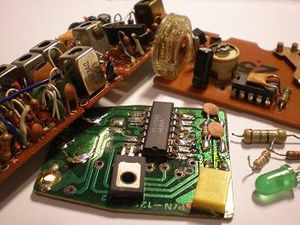Electronics
Electronics is a technology for automation and the basis for modern information technology. For remote controlled explorations and during the setup phase of a settlement on Mars it is required for radio link and data processing.
Vacuum tube
This is the oldest kind of electronic device. It is made from glass and metal. Compared with semiconductor electronics the tubes are big, power consuming, but they are easier to produce. They are radiation-proof, which makes them suitable for long term applications under Martian environmental conditions. Nevertheless, the wear lifespan is limited by abrasion of the heating electrode.
- Vacuum tube are used as switches and amplifier in electronic circuits, with an anode, a cathode and a number of intermediary grids depending on the function.
Semiconductors
Semiconductors are build for very pure silicon with a dopant added to obtain the required characteristics. Multiple refinement stages are required to obtain the desires purity. The final form of the silicon are 'boules' drawn from a basin of molten silicon and then cut into wafers. As the manufacturing processes improves, the sizes of the boules and the number of transistors than can be etched onto them has grown following an empirical growth formula called Moore's law, with the number of transistors doubling roughly every two years. Silicon is widely available on Mars and the same semiconductors required for transistors are also required for silicon based solar cells. So the demand for solar cells will probably define the market for semiconductors on Mars and define the required installations for their production.
- Minimal fabs(reference) are a possible alternative to the multi billion dollars semiconductor fabs that exist today, and might be applicable to Mars and the small runs of product required for its industry. Using simpler 1/2 inch (12mm) wafers, they are simpler to produce than the current wafers that reach sizes of 300mm.
Fabrication on Mars
Semiconductors are build for very pure silicon with a dopant added to obtain the required characteristics. Multiple refinement stages are required to obtain the desires purity. The final form of the silicon are 'boules' drawn from a basin of molten silicon and then cut into wafers. As the manufacturing processes improves, the sizes of the boules and the number of transistors than can be etched onto them has grown following an empirical growth formula called Moore's law, with the number of transistors doubling roughly every two years. Silicon is widely available on Mars and the same semiconductors required for transistors are also required for silicon based solar cells. So the demand for solar cells will probably define the market for semiconductors on Mars and define the required installations for their production.
- Minimal fabs(reference) are a possible alternative to the multi billion dollars semiconductor fabs that exist today, and might be applicable to Mars and the small runs of product required for its industry.
See also
| This article is a stub. You can help Marspedia by expanding it. |







